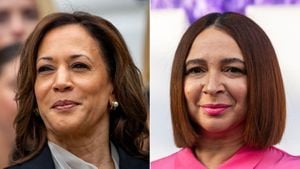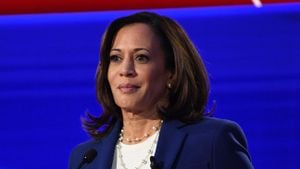Former President Donald Trump has made history again by winning the 2024 presidential election, marking one of the most astonishing comebacks in American politics. After suffering defeat to President Joe Biden back in 2020, Trump’s return to the White House has highlighted the intense divisions within the nation and characterizes much of his political narrative since he left office.
Trump declared victory over Vice President Kamala Harris early Wednesday morning after securing key battleground states. By winning North Carolina, Georgia, Pennsylvania, and Wisconsin, he crossed the 270 electoral votes needed for presidency. Currently projected to achieve 276 total votes, Trump’s victory was unexpected, especially following his tumultuous period marked by multiple indictments and legal battles.
Upon hearing the news of his success, Trump embraced his supporters, declaring, “We overcame obstacles nobody ever thought we could.” He promised to fight for American families, claiming this victory heralded the beginning of what he terms the "Golden Age of America.”
His campaign revolved around populist themes like economic recovery, immigration reform, and combating inflation, which appeared to resonate deeply with voters. His message tapped directly to the grievances of many Americans, particularly those who felt left behind during the Biden administration.
According to exit polls, Trump outperformed with White voters without college degrees and made notable gains with Black and Latino men, underscoring his ability to attract new demographics to his base of supporters. Particularly telling was the shift among independent voters, especially in Georgia, where they sided with Trump, contrary to their backing of Biden four years prior.
Issues surrounding inflation and economic conditions became front and center during the campaign. National sentiments reflect increasingly negative views on the current economy, paving the way for Trump's frequent criticisms of Biden and Harris. Many voters articulated feeling financially worse off now than they did four years ago. This dissatisfaction proved pivotal for Trump, opening avenues to win their support.
Interestingly, Trump’s messaging on immigration, which has been his hallmark for nearly a decade, continued to find traction. Voters expressed confidence he would manage to handle illegal immigration more effectively than his opponents. He pledged to enforce mass deportations, and such hardline stances contributed to his appeal among many who view border security as integral to national safety.
Adding layers to these dynamics is Trump's status as the first convicted felon elected president. He is currently awaiting sentencing for his conviction stemming from the New York hush money trial, scheduled for November 26. His presidency raises questions about governance and legitimacy, especially as he faces separate inactive criminal charges.
Trump's resilience throughout this campaign was stark. His political life has seen its share of moments of personal and political peril, including two assassination attempts. The incident during one rally this past July, where he was shot at but emerged unscathed, reinforces the polarized environment surrounding him and perhaps emboldened his messaging of strength and determination.
Starting his 2024 campaign almost two years prior, Trump built upon the unrest frosted from the 2020 election fallout and the dissatisfaction with the Biden administration's governance. Though facing active investigations and numerous indictments, he managed to galvanize his followers and frame his message as one of retribution against political enemies.
His rhetoric has remained largely unchanged—combative, polarizing, and defiant. During his rallies, he framed his candidacy as the final battle, claiming, "I am your warrior, I am your justice," emphasizing his role as the champion for those he claimed had been wronged by the political establishment.
His return to the White House doesn't just signify his political revival; it also reflects the disarray and fragmentation within American political spheres. His victory maintains his position as the focal point of the Republican Party, which rallied behind him even amid his legal challenges. His combination of loyalty from core supporters and new voter engagement proves to be effective strategies, even as opinions on his leadership styles remain drastically divided.
The Trump campaign also tapped significantly on many of the elevator issues within contemporary society. His strategy of leveraging cultural grievances and portraying himself as the defender against societal decay proved potent enough to win over minds and ballots alike.
Trump’s political style, marred by unapologetic bravado and incendiary dialogue, continues to receive criticism, yet it remains wholly captivating to his base. Throughout the final weeks of the race, he consistently claimed his victory would be “too big to rig,” sowing seeds of doubt about the integrity of the electoral process, instigated by his belief of being cheated out of the 2020 election—despite the absence of evidence to back this claim.
With each rally and campaign event, Trump amplified his warnings against perceived corrupt political adversaries, painting the political terrain as steeped in fraud and falseness. These reflections of social turbulence paired with his narrative insistently drew contrasts between his leadership expectations and the realities under the political opposition.
His campaign also emphasized heavy logistical groundwork: Trump took to battleground states where his message had the best echo and most significant emotional resonance. It became not just about the issues at hand, such as the economy or immigration, but about creating an emotional narrative rooted firmly against the backdrop of American roots—an appeal to those fearful of sociopolitical changes.
Trump’s rhetoric often positioned him against the so-called political elite, and many observers believe he has redefined party allegiance through his populist spins on various issues, moving the Republican party ideologically closer to his brand of politics, one marked by confrontation, insurrection, and fervently held beliefs about nationalism.
With the dust still settling from this combative electoral battle, Trump's second administration will reveal the subsequent intersections of the polarizing forces at play within America's political fabric. Observers and analysts across the political spectrum are now left to ponder not just the future under the returning Trump presidency but also the enduring impacts of such polarization on governance and collective civil discourse.



